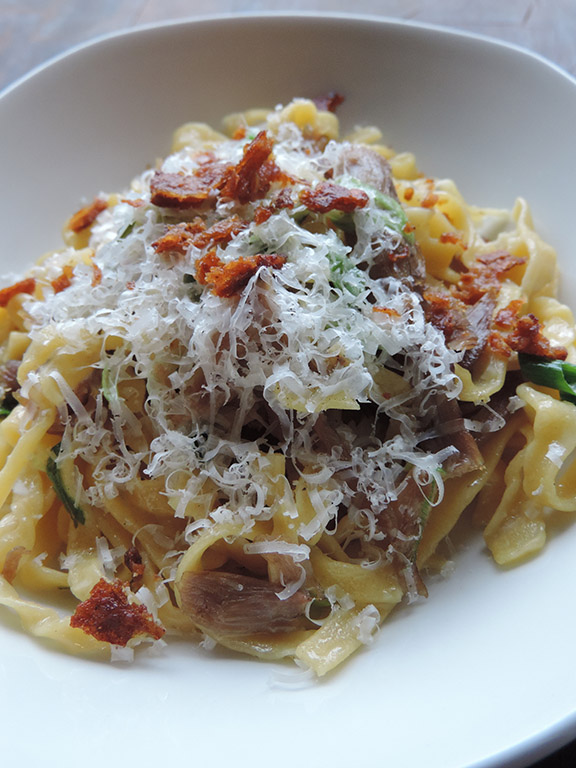
Pasta:
6 duck eggs
4 cups 00 pasta flour
1 Tbsp. extra virgin olive oil
2 Tbsp. whole milk
Duck Confit:
1 cup kosher salt
4 duck leg hindquarters
2 lb. rendered duck fat
¼ cup sugar
1 tsp. cracked black peppercorns
1 bunch thyme
3 bay leaves
4 cloves garlic
1 bunch of scallions
as needed for serving, Parmesan cheese
as needed for serving, crispy duck skins
For duck confit: Combine kosher salt, sugar, freshly cracked black peppercorns, thyme, bay leaves and thinly sliced garlic cloves together in a small bowl. Generously rub the salt mixture on the duck leg hindquarters, place in a nonreactive container, cover and refrigerate for 5 hours, or overnight.
After duck legs have cured, rinse them under cold running water and dry with paper towels. Preheat oven to 250°F, place dry duck legs in a small square baking dish in one layer. Melt duck fat over medium heat in a saucepan. Carefully pour melted duck fat over duck legs so they are submerged. Place duck legs in a preheated oven for 4 hours, then carefully remove duck from oven and allow to cool slightly. With a slotted spoon, remove duck legs and place on a cutting board. Carefully remove the duck skin and place on a lined baking sheet. Remove bones and cartilage, pull duck meat apart and place in a bowl until ready to serve. Strain duck fat and reserve for another use.
For pasta: Pasta dough can be made by hand or in a mixer, but the finish kneading should be done by hand to create the best-tasting pasta. Combine 3 duck eggs and 3 duck egg yolks with 1 Tbsp. extra virgin olive oil, 2 Tbsp. whole milk and a pinch of kosher salt. Whisk egg mixture until combined. On a clean counter, make a mound of roughly 3 cups of 00 pasta flour; create a well in the center and pour in egg mixture. Using a fork, slowly incorporate flour into egg mixture. When dough is combined enough to form a ball, knead with the palm of your hand for 6 to 8 minutes, or until dough will not take on any more flour and will spring back when you push on it gently. Wrap dough in plastic wrap and allow it to rest in the refrigerator for at least 45 minutes.
Cut pasta dough into 4 equal pieces. On a lightly floured surface, press dough into a rectangle shape. Using the widest setting, roll the pasta 10 times, making sure dough is floured to prevent sticking. After the 10th pass, fold dough in thirds and pass dough 10 more times, keeping the dough floured. Adjust roller to the second-widest setting and pass the dough 3 more times. Continue with each setting until desired thickness (the fourth setting is preferred). Cut pasta sheets approximately 10 inches long. Using fettuccini cutter, cut sheets into noodles. Repeat process for all of pasta dough. After cutting, allow pasta to dry on pasta-drying rack or a sheet tray until pasta is ready to cook.
Heat oven to 350°F. Place pan with duck skins in oven and bake for 10 to 15 minutes, or until duck skins are crispy but not burnt. Place on a dry paper towel until ready to serve.
Thinly slice one bunch of scallions on a bias. In a large sauté pan over medium heat, add 1 Tbsp. duck fat. After fat melts, add pulled duck meat and scallions; season with salt and pepper.
Fill a large pot with salted water and bring to a boil. When water reaches a rolling boil, drop in pasta, stirring occasionally to prevent sticking. Fresh pasta cooks in about 2 minutes. When pasta float s, taste a noodle for doneness. When pasta is cooked to your liking, drain and toss pasta in sauté pan with duck. Taste and re-season with salt and black pepper.
Serve pasta in a bowl and top with shaved Parmesan cheese and crispy duck skins.




